Welding is a metal fabrication process that joins metal components by using high heat to melt the base pieces together. After cooling, the two components are fused. A filler metal is usually used to strengthen the welded joint. The melted filler metal is known as a weld pool. A shielding gas is usually used to prevent oxidation or contamination.
Types of Welding

Microform Precision provides MIG and TIG welding for stainless steel, mild steel, and aluminum. Spot welding is available for most metals except for aluminum.
Both MIG and TIG welding use an arc welding process. Electricity is used to heat metal to the melting point, and the pieces of metal being welded are joined when the metal cools. A shielding gas is used to prevent atmospeheric contamination.
MIG welding is an abbreviation for Metal Inert Gas welding. In MIG welding, a spool of welding wire is fed continuously through a liner to a contact tip. This contact tip is connected to the power source. As the trigger is pulled, the wire feeds, the contact tip is hot (electrically charged), and the wire is melted for the weld puddle.
As the trigger is pulled, an inert gas like argon or helium, or carbon dioxide also flows from the gun. This inert gas acts as a shielding gas from the regular atmosphere (nitrogen, oxygen, carbon dioxide). By using a shielding gas, the weld puddle is more likely to be free from weld defects.
One advantage of MIG welding is it can be used for a wide variety of material thicknesses, from thin gauge sheet metal to thicker plates.
TIG welding stands for Tungsten Inert Gas welding. In TIG welding, a tungsten or tungsten alloy electrode is used to conduct electricity. Tungsten has the highest melting temperature among pure metals.
Most often, TIG welding is used for thinner gauged sheet metals. TIG welding can operate at lower power levels, and can be a slower and more delicate process than MIG welding.
Spot welding is also sometimes called resistance spot welding. The fusing of two metal surfaces by way of heat generated by resistance to an electric current. This is typically done on a dedicated machine as opposed to a standard welding machine. Two tips in a jaw-like configuration must be permitted to close and press the two surfaces together. For this reason, clearance and access to the intended spot weld location should be a consideration.
Considerations for Welding

Welding introduces a lot of heat and has the potential to cause deformation. We advise specifying the exact locations and intervals at which weld is required, keeping those as sparse as can be tolerated for your application. This will minimize the potential of heat-related deformation.
Microform Precision does not specialize in welds on cosmetic materials such as #4 or #8 finish stainless steel.
All of Microform Precision’s metal fabrication services, including welding, are in-house only. Installations or other on-site processes cannot be provided.
Tolerances for Welding
| 2 Place Dimension | +/- 0.06″ |
| 3 Place Dimension | +/- 0.03″ |
Our Welding Equipment
| Type | Make | Model |
|---|---|---|
| MIG welding machine | Miller | Millermatic 212 (x2) |
| MIG welding machine | Miller | Millermatic 210 (x2) |
| MIG welding machine | Miller | Millermatic 350P (x3) |
| TIG welding machine | Miller | Dynasty 210 (x2) |
| TIG welding machine | Miller | Dynasty 280 (x2) |

